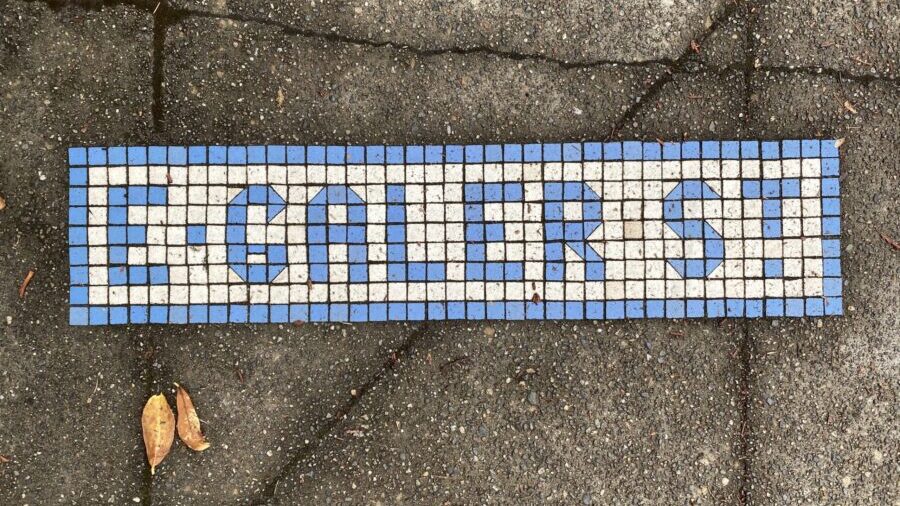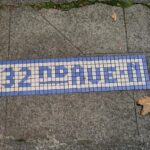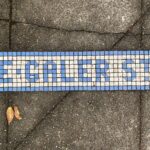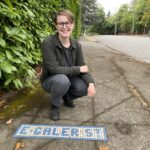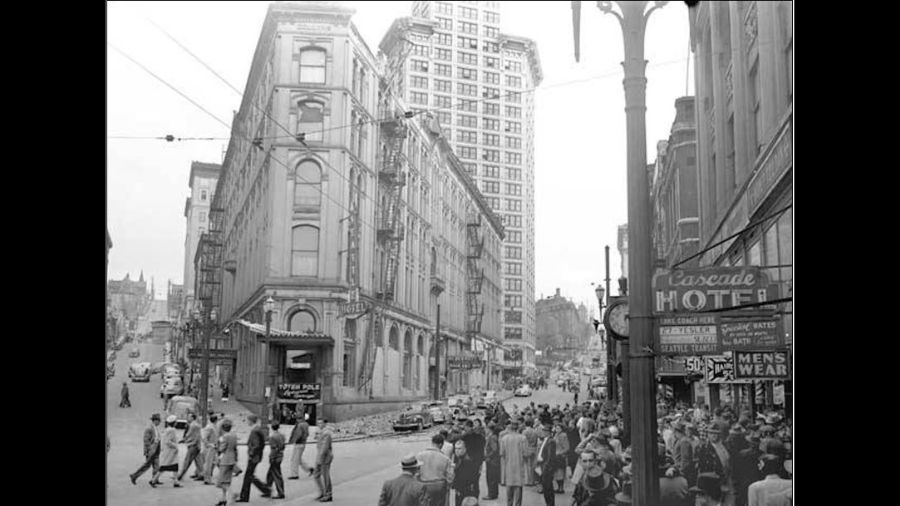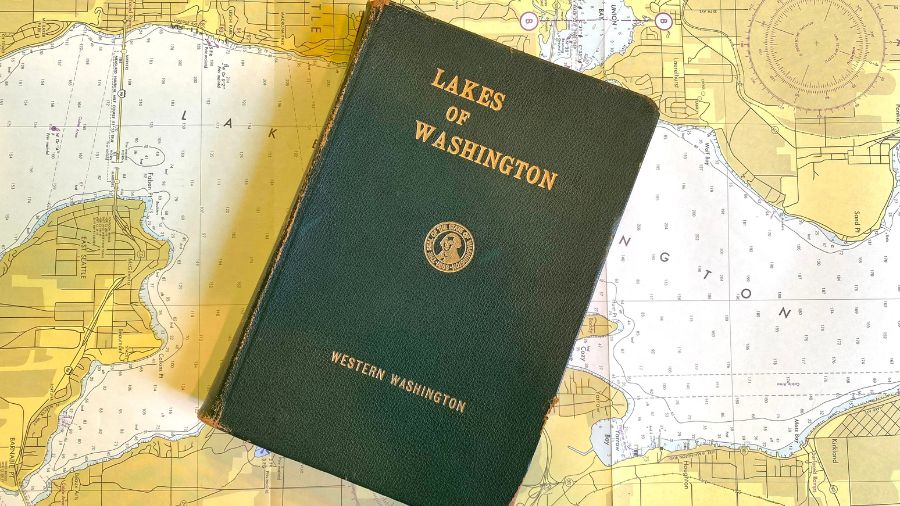Mystery and tragedy of Seattle’s old tile street markers
Aug 9, 2023, 9:21 AM
KIRO Newsradio’s story last week about hidden relics from an old cable car line inspired a listener to reach out in search of the origins of a distinctive set of markers along that same thoroughfare: Madison Street, the main connector between Elliott Bay and Lake Washington since the 19th century.
It turns out that those origins proved to be a mystery – until a local author tracked down the clues and pieced together the bizarre and ultimately sad story.
The local author is Susanna Ryan. KIRO Newsradio first talked to her two years ago when her book Secret Seattle: An Illustrated Guide to the City’s Offbeat and Overlooked History was published. Ryan specializes in street-level history, investigating the tiniest of details, sussing out the origin stories, and creating pretty amazing illustrations, too.
Susanna Ryan spoke to KIRO Newsradio a few days ago at the intersection of East Madison Street and East Galer Street while standing over a unique piece of directional sidewalk ornamentation.
“I’d say what we have here is a set of tiles, possibly two feet wide, by a half foot wide, and it’s got a blue tile border,” Ryan said. “And then, in the middle of it, there’s kind of a sea of white with blue letters that say the street or the name of the street.”
“Right now, we’re looking at East Galer Street,” Ryan confirmed.
At first glance, the tile street names have a certain timeless quality, or they at least look like they could be from the relatively recent past. Maybe it’s the colors or maybe the font, but the markers might even be described as having a certain 1980s “Laura Ashley” quality.
Susanna Ryan noticed the tiles, of course, the way she notices everything else, as she walks around Seattle and shares what she finds. For the tile street marker backstory, Ryan told KIRO Newsradio that she searched online and through newspaper archives, but all she could find at first was an article from the old Seattle P-I from 30 years ago saying that nobody knew the origins of the tile street names.
“It had been my greatest unsolved walking mystery for so long I had almost completely let go of the idea that I would ever solve it,” Ryan admitted. “Greater minds before me had tried and not been able to come up with anything.”
“So I was like, maybe that’s it,” Ryan said. Having hit only dead ends, the tiles were not featured in Secret Seattle.
Fortunately, despite the book being published, Susanna Ryan didn’t give up. Two clues helped narrow the search.
One clue was that the directional suffix on some of the tiled street names said ‘N’ for “North” – including the examples which Greg Schlosser shared. Ryan knew that the prefixes and suffixes for those particular streets had been changed from “North” to “East” back in 1961. Thus, Ryan could surmise that the tiles predated 1961. But by how many years? That part wasn’t clear.
The second clue was a name formally stamped into the sidewalk – whenever the concrete had first been poured – right next to that Galer Street tile marker where Ryan met up with KIRO Newsradio a few days ago.
The stamp included the name of the contractor – which is how some sidewalks used to be marked decades ago. That contractor name was exactly the clue Susanna Ryan needed to go back to the newspaper archives, do some more keyword searching, and then track down a brief article describing a city-funded sidewalk construction project on Madison Street – which also included details about the tile street name markers.
The year? It turns out that the tile street markers on Madison Street date to the summer and fall of 1904, or nearly 120 years ago.
“I’m not sure who the person was who initially proposed it,” Ryan said, referring to the then-new notion of embedding the street name in the sidewalk, “but they were so enthusiastic about the idea that they said, ‘Okay, every single new sidewalk going forward is going to have these beautiful blue and white tile markers.’”
“They gave the contract to this guy named Harry Collins, who was actually the person who had started Seattle’s very first tile and mantel store after moving here in 1889 from New York, sensing, I think, that the people of Seattle would need some tiles,” Ryan said.
It was in June 1889 when most of downtown was wiped out by the Great Seattle Fire – and a major amount of reconstruction work was underway almost immediately afterward, likely a boon for Collins’ nascent tile empire. Fast-forward 15 years to the summer of 1904, and it was Collins’ good fortune that tile street-name markers were all the rage in Seattle.
How, exactly, did tile street markers become so popular?
“The year before, in 1903, the city had conducted a street name signage experiment where they installed both 1″-tall metal letters with the street’s name in new sidewalks and iron signs on posts to see which signage method people preferred,” Susanna Ryan explained in an email. “While the iron signs won out, it didn’t stop the city’s interest in investing in other ways to improve street name visibility, with a special interest in doing so along trolley lines where people would be zooming by quickly and may not be able to see a smaller posted sign.”
Back at Madison and Galer, Susanna Ryan read from a Seattle Post-Intelligencer article from June 1904.
“The signs are of tiles and are placed at the intersections of streets in the pavement, where he who runs or even writes past may read,” Ryan read. “The new signs are made of tiny squares and half squares of blue and white tiles set in the cement. And the lettering is large and clear. The tiles are set first in a frame of iron squares in the design required, then glued paper is applied to the backs, and the design is transferred to the paper. Then the setup sign is placed on the pavement, and the cement bed is hardened. The new signs are a great relief to those who have been for years craning their necks in an effort to find out where they are at and are also said to have the advantage of being fairly indestructible and permanent.”
That last part – “fairly indestructible and permanent” – made Ryan chuckle.
“Which I think, 100 years later, we can kind of agree they figured that out,” she noted.
For tile impresario Harry Collins, it was a golden age in turn-of-the-20th-century Seattle, and he must have been thrilled to have his company tapped to create tile street markers in 1904 and to look ahead to years of additional work outfitting every new sidewalk the same way.
Unfortunately, that golden age didn’t last.
“Six months later, in December 1904, from the Seattle P-I,” Susanna Ryan said, there’s “this very short little – if you can even call it an article – [with the] headline, ‘SIGNS ARE WORTHLESS.’”
“And then it reads,” Ryan continued, “‘The street committee at its meeting yesterday instructed the Board of Public Works to use no more tiling street signs in the pavement, as such signs are considered worthless.'”
“And then they were never mentioned again,” Ryan said.
Worthless? Ouch.
It’s unclear exactly why the tiles were deemed ‘worthless’ so quickly after they had been embraced as a solution for street signage, but Susanna Ryan thinks they likely proved ineffective for people moving increasingly faster via cable cars as well as horse-drawn buggies. Automobiles, in any great number in Seattle, were still a few years away in 1904.
Then, as if that great tile collapse of 1904 weren’t enough humiliation of poor old Harry Collins, an ever greater tragedy was to strike just a few years later.
“He actually continued to tile about town for a couple more years,” Ryan said. “And then, in 1910, he had an office on Marion Street.”
One night, Ryan says, Collins escorted his wife from his Marion Street office to a streetcar for the ride to the family home on Queen Anne Hill.
“And he took the 10-minute walk to King Street Station with his tile samples in tow, going to Canada on a work trip,” Ryan continued. “And several minutes after the train took off from King Street Station, he died. He died aboard the train … in the Great Northern Tunnel.” Collins was just 46 years old but had been suffering from heart problems.
Tile maven Harry J. Collins, says Susanna Ryan, “may have been among the first people to die in that Great Northern Tunnel. How dramatic with tile samples.”
According to more old newspaper clippings, the Collins family was big on tiles beyond Harry’s work in Seattle. While’s it unclear what happened to the family business here, Harry’s brother Burton V. Collins was the tile king of Los Angeles, winning several government contracts well into the 1930s.
It’s also unclear just how many tile street markers were created by Harry J. Collins for the City of Seattle during that brief window of popularity in 1904. Inquiries to the Seattle Department of Transportation about the tiles, the total number remaining, the existence of an inventory, and whether or not there are special provisions for caring for the 119-year-old relics – have not yet borne out any additional information.
Ryan offered a cautionary note by email for aspiring sidewalk historians.
“One big caveat is that this may not apply to the tile markers seen in Ballard today,” Ryan wrote. “In the mid-1990s, the Central Ballard Community Council received a grant from the Department of Neighborhoods to place new tile street name markers in the same style as the old ones, using the neighborhood’s old street names.”
For Susanna Ryan, ferreting out the backstory – and uncovering the sad tragedy – of the tile street markers is, in some ways, just another day at the office. But she clearly thrives on the wonder and the discovery, as well as the humanity that can be embodied by even a modest sidewalk artifact.
“Another reason why, in addition to the kind of just noticing these little things about the neighborhood, [is] that craftsmanship, that love, that little human touch that is put into these things like this,” Ryan said, “that isn’t quite the same as the way that things are made today, and construction happens today.”
Ryan also can’t help but imagine the sheer numbers of people who, unwittingly, for the most part – have interacted with those artifacts every day for well over a century.
“To think about how many thousands of people have walked across that little patch over all these years,” Ryan said. “I think it’s really cool.”
You can hear Feliks every Wednesday and Friday morning on Seattle’s Morning News with Dave Ross and Colleen O’Brien, read more from him here, and subscribe to The Resident Historian Podcast here. If you have a story idea, please email Feliks here.

